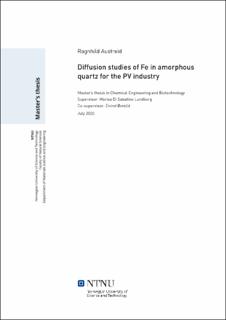| dc.contributor.advisor | Di Sabatino Lundberg, Marisa | |
| dc.contributor.advisor | Øvrelid, Eivind | |
| dc.contributor.author | Austreid, Ragnhild | |
| dc.date.accessioned | 2021-09-28T18:08:30Z | |
| dc.date.available | 2021-09-28T18:08:30Z | |
| dc.date.issued | 2020 | |
| dc.identifier | no.ntnu:inspera:59532294:35998621 | |
| dc.identifier.uri | https://hdl.handle.net/11250/2785274 | |
| dc.description.abstract | Kvartsdiglene som brukes til å støpe multikrystallinsk silisium (mc-Si) til solcelleindustrien er en dominerende forurensningskilde i silisiumproduksjonen. For høye konsentrasjoner av metalliske urenheter, som jern, i silisium er svært ødeleggende for strømutbyttet til solcellen. Derimot er det få studier og publikasjoner som undersøker diffusjonsmekanismene til jern i diglene og hvordan jernet forurenser silisiumet. Formålet med denne oppgaven er derfor å måle diffusjonskoeffisienten til jern i amorfe kvartsdigler (SiO2) for å bidra til forståelsen av hvordan jernet diffunderer inn og forurenser mc-Si ingoten. En kvantitativ analyse av jerndiffusjon i kvartsdigler er presentert. Varmebehandling av diffusjonspar bestående av en standard kvartsdigel og stål, med syntetisk kvartsglass som referanse, utføres i en GSL-1500X-50RTP rørovn. Diffusjonskoeffisienten måles i vakuum for temperaturområdet 900-1300 °C og konsentrasjonsprofilene av jern måles ved bruk av glødeavladnings massespektrometer (GD-MS). Resultatene fra arbeidet kan videre brukes til å modellere fordelingen av jern i silisiumingoten. I tillegg inkluderer denne avhandlingen en litteraturdel om diffusjonsstudier i kvarts. En generell oversikt over diffusiviteten til ulike elementer målt i kvarts er oppsummert og sammenlignet.
I temperaturområdet 900-1300 °C, ble følgende Arrhenius forhold målt for diffusjonen av jern i henholdsvis kvartsdigelen og kvartsglasset,
D = 6.53∙10^(-8)exp(-1.154 eV/kT) cm^2/s
D = 1.05·10^(-9)exp(-0.937 eV/kT) cm^2/s
Diffusiviteten av jern i kvartsdigelen ble funnet til å være en størrelsesorden høyere enn diffusiviteten av jern i syntetisk kvartsglass, med målte diffusjonskoeffisienter i området 10^(−13)-10^(−11) cm^2/s i kvartsdigelen sammenlignet med 10^(−14)-10^(−12) cm^2/s i kvartsglasset. GD-MS viste seg å være en god metode for å oppnå konsentrasjonsprofilene av jern i de to kvartsmaterialene med beregnede sputteringshastigheter på henholdsvis 0.57 nm/s og 0.30 nm/s for digelen og kvartsglasset. | |
| dc.description.abstract | Crucible materials have been identified as a dominant contamination source during the solidification process of multicrystalline silicon (mc-Si) ingots for solar cells. Too high concentrations of metallic impurities, such as iron, in the silicon are detrimental to the solar cell performance. However, there are few studies and publications on the diffusion mechanisms and behaviour of iron in quartz crucibles. To address this, this study aims to measure the diffusion coefficient of iron in amorphous quartz (SiO2) crucibles to gain a better understanding of the iron in-diffusion and contamination in mc-Si. A quantitative analysis of iron diffusion in quartz crucibles is presented. Heat treatment of diffusion couples consisting of slip-cast crucible and steel, with synthetic quartz glass as a reference, is performed in a GSL-1500X-50RTP tube furnace. The diffusion coefficient of iron is measured in the temperature range 900-1300 °C, in a vacuum atmosphere. Concentration vs depth profiles are measured using glow discharge mass spectrometry (GD-MS). The results of the work can be used further as input parameters to predict by modelling the iron distribution in the mc-Si ingots. Further, this thesis also includes a literature review on diffusion studies in quartz. A general overview of the diffusion behaviour of different elements measured in quartz is summarised and compared.
Over the temperature range 900-1300 °C, the following Arrhenius relations were obtained for the diffusion of iron in a standard grade silica crucible and synthetic quartz glass, respectively,
D = 6.53∙10^(-8)exp(-1.154 eV/kT) cm^2/s
D = 1.05·10^(-9)exp(-0.937 eV/kT) cm^2/s
The diffusion of iron in the slip-cast silica crucible was found to be one order of magnitude higher than in the synthetic quartz glass, with measured diffusion coefficients in the range of 10^(−13)-10^(−11) cm^2/s in the silica crucible compared to 10^(−14)-10^(−12) cm^2/s in the quartz glass. GD-MS proved to be a sufficient method for obtaining the concentration vs depth profiles with calculated sputtering rates of 0.57 nm/s and 0.30 nm/s for the silica crucible and quartz glass, respectively. | |
| dc.language | | |
| dc.publisher | NTNU | |
| dc.title | Diffusion studies of Fe in amorphous quartz for the PV industry | |
| dc.type | Master thesis | |
